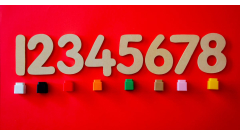Embarking on the journey of learning Italian can open up a world of opportunity and cultural appreciation. With Collins Easy Learning Italian, you'll discover an inviting path to enhancing your vocabulary, making everyday conversations in Italian feel effortless and exciting. This guide isn't just about rote memorization; it invites you to engage with the language in a way that's both practical and enjoyable.
As you dive into this easy-to-navigate resource, you'll find that it’s structured to complement your learning style. Each section is designed to help you assimilate new words through context and real-life examples, allowing you to build your language skills organically. This isn't merely a vocabulary builder; it's an invitation to explore the richness of the Italian language while gaining confidence in your conversational abilities.

Collins Easy Learning Italian is a comprehensive resource designed to help learners grasp the essentials of the Italian language with ease. Featuring clear explanations and engaging exercises, this guide focuses on vocabulary development within practical contexts. Whether you are just starting your Italian journey or looking to enhance your conversation skills, this book serves as a valuable tool to boost your confidence and help you communicate effectively. Experience the joy of speaking Italian while diving into the vibrant culture that inspires it!
Flashcard Creation
Creating flashcards is an effective way to enhance your vocabulary retention while using the Collins Easy Learning Italian ― Easy Learning Italian Conversation guide. Begin by selecting a list of key vocabulary that resonates with you. Focus on words that are frequently used in conversations or that pertain to a specific theme, like travel, food, or daily activities. This ensures that the words you are practicing are relevant to your learning goals. When choosing vocabulary, consider including not just nouns, but also verbs, adjectives, and useful phrases.
Once you've picked your words, organize them into categories. For example, you might create a set of flashcards for greetings, household items, or common verbs. This thematic approach helps in associating words with contexts, which strengthens memory recall. To make your flashcards visually appealing and memorable, utilize drawings, images, or even clip-art that represent each word. This visual cue can significantly enhance retention. Aim to include the Italian word on one side and its English equivalent, along with a simple image, on the other. Additionally, practice regularly with these flashcards, mixing up the order to challenge yourself and reinforce learning.
- Choose high-frequency vocabulary from the Collins guide.
- Group words by theme for systematic learning.
- Add visuals to enhance memorization.
- Regularly practice with shuffled flashcards.
Daily Practice Routine
Creating a daily practice routine using the Collins Easy Learning Italian guide can significantly enhance your vocabulary retention and conversational abilities. Start your day by dedicating 15-20 minutes to reviewing vocabulary. Focus on specific themes each day to build relevant lexicons, such as:
- Monday: Food and Drink - Practice terms related to cooking, ingredients, and dining out.
- Tuesday: Travel - Review phrases used in airports, hotels, and asking for directions.
- Wednesday: Work and Professions - Familiarize yourself with job-related vocabulary and office terms.
- Thursday: Hobbies and Free Time - Learn vocabulary surrounding leisure activities, sports, and entertainment.
- Friday: Family and Relationships - Focus on words associated with family members, friends, and social interactions.
- Saturday: Daily Routines - Reinforce words that describe everyday actions and tasks.
- Sunday: Review Day - Go over all themes from the week to consolidate knowledge.
Incorporate engaging methods such as flashcards, mobile apps, or language learning platforms to check your progress. Setting reminders on your phone can be a great way to stay consistent. Allocate five minutes during the day to utilize an app that reinforces vocabulary through quizzes or games. Another effective approach is to jot down new words in a notebook and practice writing simple sentences with them. Keeping your practice varied will keep you motivated and enhance retention.
- Use visual aids, like pictures or infographics, to associate words with images.
- Engage with Italian media, such as podcasts or videos, to hear the vocabulary in context.
- Consider practicing with a language partner or tutor online to apply what you’ve learned in real conversations.
Utilizing Mnemonics
Building vocabulary with the Collins Easy Learning Italian can be greatly enhanced by the use of mnemonics. These are creative memory aids that help anchor new words in your mind by associating them with familiar notions or imagery. To create effective mnemonics, start by considering the sound and meaning of the Italian word you're trying to remember. Then, devise a connection that makes sense to you. Personalized associations will stick better in your memory.
For example, let’s look at a few common Italian words and explore some mnemonic devices:
- Casa (house): Think of a "cozy" house, where you enjoy "coffee". The "ca" in casa sounds like "cozy" and "ca" in coffee.
- Libro (book): Imagine a library filled with books. The first two letters "li" can remind you of "library".
- Amico (friend): Picture a "mi" grant "co" (as in co-worker). Just imagine your friend also working alongside you.
Encouraging users to develop their own mnemonic devices is vital. Look for unique personal experiences or perceptions that relate to the vocabulary. The more vivid your association, the more effective it will be. You may create a quirky image, a song, or even a silly story linking the word to its meaning, enhancing your recall when you encounter these words in conversation.
- Think of an Italian dish you love and link its name to an Italian vocabulary word.
- Create a funny phrase or drawing to visualize the connection.
Engaging with Native Media
Building your Italian vocabulary through media is an exciting and effective strategy. With "Collins Easy Learning Italian: Easy Learning Italian Conversation," you have a solid foundation for understanding conversational Italian. Leveraging podcasts, films, and music can help you immerse yourself in the language and culture. Start by selecting Italian-language media that genuinely interests you. Whether it's a popular podcast, an engaging film, or your favorite Italian songs, finding content you enjoy will keep you motivated. Listen and watch attentively, allowing yourself to be drawn into the storytelling and conversations.
Active engagement is key to maximizing your learning experience. As you encounter new words and phrases, make it a habit to pause and jot them down. Create a dedicated notebook or a digital document where you can compile your vocabulary lists. Consider these steps for effective note-taking:
- Write down the context in which you heard or saw the new word.
- Include translations and any synonyms or related phrases.
- Try to use the new vocabulary in sentences of your own.
In addition to writing, repeat the phrases aloud to practice pronunciation. This multisensory approach reinforces your memory. Explore various media types to challenge yourself and keep the learning process dynamic.
- Choose different genres or themes to expand your vocabulary range.
- Engage with interactive media like language-learning apps that incorporate native content.
Conversation Practice
Enhancing your vocabulary through conversation is crucial when using the Collins Easy Learning Italian guide. Engaging in conversations helps solidify the words and phrases you’ve learned, transforming them from mere memorization into active use. One effective method for practicing is to find a language partner, someone who is either a native Italian speaker or another learner. This partnership can foster a supportive environment where both parties feel comfortable making mistakes and learning from each other. You can schedule regular conversation sessions to discuss various topics or even practice role-playing scenarios that might come up during real-life conversations.
Additionally, leveraging technology can greatly enhance your conversation practice. Using language exchange apps allows you to connect with Italian speakers around the world who want to learn your native language. This reciprocal arrangement not only immerses you in authentic dialect and slang but also gives you a chance to practice vocabulary in different contexts. Furthermore, practicing in front of a mirror can help improve your confidence and pronunciation. This method enables you to observe your facial expressions and body language while speaking, which is essential for effective communication.
- Join language meetups or groups in your local area to interact with others learning Italian.
- Record your speaking sessions to analyze your pronunciation and intonation.
- Use flashcards to reinforce vocabulary before engaging in conversation.
- Explore themed discussions based on the sections of the Collins Easy Learning Italian guide.
Word Association Games
Building your Italian vocabulary can be both effective and fun with Collins Easy Learning Italian. One engaging method to practice is through word association games. These activities can be played alone or with friends, making them versatile tools for vocabulary reinforcement. Consider starting with a game like "Word Chains," where players take turns saying a word that begins with the last letter of the previous word. For example, if one player says "cane" (dog), the next player might say "elefante" (elephant). This not only helps in learning new words but also encourages quick thinking and recall. To make it more challenging, set a timer for each turn or restrict the category of words (like animals or food) to elevate the difficulty based on skill levels.
An alternate game to try is "Categories." Players select a category, such as fruits, and then take turns saying an Italian word that fits that category, with no repetitions allowed. This encourages players to think about their vocabulary actively. For those with different skill levels, you can adapt the game by allowing beginners to use English alongside Italian translations, slowly phasing out the English words as they gain confidence. Ensure to keep the atmosphere light and encouraging; the goal is to learn while having fun!
- Word Chains: Use any category to keep it interesting.
- Categories: Great for testing knowledge on specific topics.
- Flashcards: Create associations with visuals for stronger memory retention.
- Pictionary: Draw words instead of saying them to enhance learning through creativity.
Contextual Learning Techniques
Building vocabulary is an essential element of mastering the Italian language, and utilizing contextual learning techniques can enhance that process significantly. When using the Collins Easy Learning Italian – Easy Learning Italian Conversation, immerse yourself in the vocabulary by creating meaningful sentences that reflect real-life scenarios. This approach not only helps you remember the vocabulary but also gives it purpose. For example, if you’ve learned the word 'cane' (dog), try to make sentences like "Il mio cane ama correre" (My dog loves to run). The personal connection to these sentences will significantly bolster your memory retention.
Delve deeper by developing short stories or diary entries that incorporate the words you’ve learned. Consider dedicating a page in your notebook for daily reflections where you use a set number of new words from the Collins guide. This practice compels you to think creatively while applying your new vocabulary. Additionally, focusing on your daily life can provide context that makes learning more relevant and fun:
- Describe a typical day using as many verbs and nouns as possible.
- Create dialogues as if you were in a coffee shop or at a market, integrating vocabulary related to those environments.
- Write about your family and friends using descriptive adjectives to enhance your vocabulary.
Regular Revision Strategies
Building your Italian vocabulary using Collins Easy Learning Italian can be a rewarding experience, especially when you incorporate regular revision strategies. The spaced repetition technique stands out as an effective method for retaining vocabulary over time. This technique involves reviewing words at strategically spaced intervals, which helps reinforce memory and promote long-term retention. Begin by categorizing your vocabulary into manageable chunks, making it easier to focus on specific themes or topics. For instance, you can start with basic greetings, followed by common verbs and adjectives. After you’ve learned a set of words, set a timetable for yourself. Review the newly learned vocabulary after 24 hours, then again after 3 days, 7 days, 14 days, and finally, 30 days. This structured approach allows you to gradually increase the time between revisions as your familiarity with the words grows.
Maintaining a vocabulary tracker can significantly enhance your learning process. Create a dedicated notebook or digital document to log the words you’ve learned. Use this tracker to record the dates of your reviews and mark the words that require more focus. To make this engaging, you could use color-coding: perhaps green for words you know well, yellow for those you still need to work on, and red for words that are particularly challenging. Regularly revisiting this tracker will help you stay organized and ensure that you're prioritizing the vocabulary that needs the most attention. To enrich your learning experience, consider incorporating activities such as flashcards, quizzes, and interactive games related to the Collins Easy Learning Italian curriculum.
- Use flashcards to reinforce vocabulary.
- Engage in conversation practice with native speakers.
- Implement quizzes to test your understanding.
Engagement with Social Media
Using social media is an excellent way to immerse yourself in the Italian language and culture while building your vocabulary. Platforms like Instagram, Twitter, and Facebook can provide continuous interaction with native speakers and like-minded learners. Begin by following popular Italian influencers who share content aligned with your interests, whether it’s fashion, food, travel, or art. This not only helps you learn new vocabulary but also exposes you to everyday conversational Italian in a natural context. Engage actively by liking, sharing, and commenting on their posts in Italian. This practice will boost your confidence in writing and speaking the language.
Joining Italian-speaking groups or forums can enhance your language skills significantly. Search for communities focused on topics that fascinate you; these could be language exchange groups or groups dedicated to Italian culture. Participating in discussions, asking questions, and providing answers helps reinforce your vocabulary and comprehension. Consider using platforms like Facebook Groups or Reddit to connect. For an engaging experience, check out the following:
- Participate in live chats or Q&A sessions hosted by Italian bloggers or influencers.
- Share your thoughts in Italian on trending topics to further practice your writing skills.
- Watch live streams or stories in Italian to test your listening skills and pick up colloquial phrases.
Creating Thematic Lists
Building vocabulary with the Collins Easy Learning Italian series can become an enjoyable and personalized experience through the creation of thematic vocabulary lists. These lists allow you to focus on specific topics or situations that resonate with your interests and daily life. Start by identifying the subjects that matter most to you—this could be anything from 'Travel', 'Food', 'Hobbies', or 'Work'. Once you pinpoint your themes, take the time to gather related words and phrases from the Collins Easy Learning Italian Conversation book. Organizing your vocabulary into thematic lists enables quicker reference and makes your practice more relevant and contextual.
To create effective thematic lists, consider the following steps:
- Choose a specific theme or situation. For instance, if you love cooking, compile a list based on kitchen vocabulary.
- Utilize the Collins Easy Learning resources to find relevant terms. Look for nouns, verbs, and adjectives associated with your chosen theme.
- Organize your vocabulary by category. Under 'Food', you might list ingredients, cooking methods, and utensils separately.
- Incorporate example sentences to practice context. This helps in understanding how to use words effectively in conversation.
- Keep your lists accessible. Write them down in a note, flashcard, or digital app for easy reference.
As you build your thematic lists, make it a habit to review and revise them regularly. This practice not only reinforces your memory but also allows you to integrate new vocabulary as you advance in your Italian skills. To add a personal touch, you might also consider:
- Including phrases that are culturally relevant to your theme—for instance, classic Italian recipes if 'Food' is your focus.
- Listening to Italian music or watching films related to your themes to enhance your vocabulary contextually.
- Creating a habit of using your thematic lists in everyday scenarios, like while cooking or planning your travels.
Why We Chose This Product
Choosing Collins Easy Learning Italian for this guide was an easy decision. It strikes the perfect balance between clarity and depth, making it suitable for anyone from beginners to those looking to refine their conversational skills. The material is straightforward yet comprehensive, providing a solid foundation upon which to grow your vocabulary with confidence.
- Engaging examples from everyday conversations
- User-friendly layout that enhances learning
- Practical tips for real-life application
- Focus on building confidence in speaking
By making this guide your go-to resource, you're investing in an enriching experience that empowers you to navigate conversations more freely and effectively. If you're ready to embrace the beauty of the Italian language, Collins Easy Learning Italian is the ideal companion for your journey.

Collins Easy Learning Italian is a comprehensive resource designed to help learners grasp the essentials of the Italian language with ease. Featuring clear explanations and engaging exercises, this guide focuses on vocabulary development within practical contexts. Whether you are just starting your Italian journey or looking to enhance your conversation skills, this book serves as a valuable tool to boost your confidence and help you communicate effectively. Experience the joy of speaking Italian while diving into the vibrant culture that inspires it!









